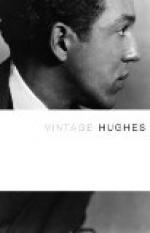|
This section contains 658 words (approx. 2 pages at 400 words per page) |

|
Vintage Hughes Summary & Study Guide Description
Vintage Hughes Summary & Study Guide includes comprehensive information and analysis to help you understand the book. This study guide contains the following sections:
This detailed literature summary also contains Style on Vintage Hughes by Langston Hughes.
Cora Jenkinsappears in Cora Unashamed
Cora is a simple black woman who lives in Melton, Iowa with her two elderly parents. Her mother is ill, and her father a drunkard. Cora supports her family by working for the Studevants, where she performs chores of every sort. Cora is described as being humble in all situations except for those in which she must face death. When her illegitimate daughter dies of whooping cough when she is just a toddler, Cora unleashes a torrent of curses so vile that she frightens her father and the nearby grave-digger. Cora's capacity for love is great and deep, and she becomes a mother figure for Jessie, the girl that is born to Mrs. Studevant around the same time that Cora's own daughter is born. When Jessie dies after being forced into an abortion by her judgmental mother, Cora refuses to remain silent at the funeral. She accuses the Studevant women of killing Jessie and is carried away from the funeral by the Studevant men. She gathers her belongings and leaves the home of her employer, never to return again.
Roy Williamsappears in Home
Roy Williams is a world-class African-American violinist who returns home to Hopkinton to his family before dying. Though he knows he is ill, he does not announce his illness to his mother, who is convinced that her home cooking will put much needed weight on her ailing son. Roy is bewildered upon his return to his hometown, as he is accustomed to the more accepting clime of Europe, having spent six years abroad playing with an orchestra. Roy plays for a packed church audience, both black and white, and wows the community with his talent. His talent, however, is not enough to overcome the racial barriers that remain firmly entrenched in the small town. When a mob of young men see Roy conversing with the white school teacher Miss Reese late at night outside the town drugstore, they accuse him of attempting to rape her and beat him mercilessly before murdering and lynching him.
Oceola Jonesappears in The Blues I'm Playing
Oceola is a talented young black pianist living in Harlem. Though she is classically trained, she spends much of her time playing for house parties and churches, where she plays largely blues music. Oceola loves playing classical, blues, and jazz music and is content to remain among her people in Harlem even though her talent could take her anywhere in the world. When a white woman named Dora Ellsworth insists on becoming her patron so that Oceola can stop playing house parties and teaching pupils, freeing her to dedicate herself to her art, Oceola is flattered and confused, but accepts the offer. Oceola travels to Paris, where she studies with a famous pianist and returns with a much improved technique. Even while in Paris, however, Oceola continues to play blues music at late night cafes for a receptive and moved audience. When Oceola returns from Europe, she becomes engaged to her boyfriend of many years, who has just completed medical school. Ellsworth opposes the marriage because she thinks it will prove a distraction to Oceola's art, and tells her protegee that she will no longer support her, but only send checks when absolutely necessary. In her final concert for her patroness, Oceola plays the blues and afterwards wonders how somebody could think that art divorced from life is better than a life richly lived.
Common folkappears in Poetry
The common folk that Hughes strove to depict in his poetry deserve some mention, even though they do not constitute any clear character set per se. Many of Hughes poems, such as "Mexican Market Woman," were a quick vignette of an ordinary, unnamed person. Always poor, always humble, and often inspiring, these characters embody Hughes vision of the common folk—the people for whom he lived and wrote, and whose struggle for justice and equality he made his own.
Read more from the Study Guide
|
This section contains 658 words (approx. 2 pages at 400 words per page) |

|




